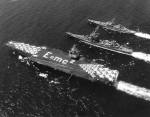Portal:Virginia
The Virginia Portal  Virginia, officially the Commonwealth of Virginia, is a state in the Southeastern and Mid-Atlantic regions of the United States between the Atlantic Coast and the Appalachian Mountains. The state's capital is Richmond and its most populous city is Virginia Beach. Its most populous subdivision is Fairfax County, part of Northern Virginia, where slightly over a third of Virginia's population of 8.7 million live. Eastern Virginia is part of the Atlantic Plain, and the Middle Peninsula forms the mouth of the Chesapeake Bay. Central Virginia lies predominantly in the Piedmont, the foothill region of the Blue Ridge Mountains, which cross the western and southwestern parts of the state. The fertile Shenandoah Valley fosters the state's most productive agricultural counties, while the economy in Northern Virginia is driven by technology companies and U.S. federal government agencies, including the U.S. Department of Defense and Central Intelligence Agency. Hampton Roads is also the site of the region's main seaport and Naval Station Norfolk, the world's largest naval base. (Full article...) Selected article
At the Battle of Malvern Hill (July 1, 1862) during the American Civil War, the Confederate Army of Northern Virginia under the command of General Robert E. Lee and the Union Army of the Potomac under General George B. McClellan clashed near Richmond, Virginia, the Confederate capital.
Confederate commander-in-chief Joseph E. Johnston had fended off McClellan's repeated attempts to take the city of Richmond as part of McClellan's ambitious Peninsula Campaign. After Johnston was wounded, Lee took command and launched a series of counterattacks, collectively called the Seven Days Battles, culminating in the action on Malvern Hill. The battle involved over fifty thousand soldiers from each side, hundreds of pieces of artillery and three warships. The Union V Corps, under Fitz John Porter, took up positions on the hill on June 30 in preparation for the battle, which began the following day. Confederate preparations were hindered by several mishaps. Nonetheless, the Confederates attacked first, when the artillery on the left flank began firing upon the Union line. The Federal artillery, however, was the story of the day, repulsing attack after attack. In the aftermath of the battle, the Confederate press heralded Lee as the savior of Richmond. McClellan was criticized harshly for his absence from the battlefield, an issue that would haunt him when he ran for president in 1864. From Malvern Hill, McClellan and his forces withdrew to Harrison's Landing where he would stay until August 16. Lee withdrew to Richmond to prepare for his next operation, as the action on Malvern Hill ended the campaign on the Peninsula. Selected biography
George Rogers Clark (1752 – 1818) was a soldier from Virginia and the highest ranking American military officer on the northwestern frontier during the American Revolutionary War. He served as leader of the Kentucky (then part of Virginia) militia throughout much of the war. Clark is best known for his celebrated captures of Kaskaskia (1778) and Vincennes (1779), which greatly weakened British influence in the Northwest Territory. Because the British ceded the entire Northwest Territory to the United States in the 1783 Treaty of Paris, Clark has often been hailed as the "Conqueror of the Old Northwest."
Clark's military achievements all came before his 30th birthday. Afterwards he led militia in the opening engagements of the Northwest Indian War, but was accused of being drunk on duty. Despite his demand for a formal investigation into the accusations, he was disgraced and forced to resign. He left Kentucky to live on the Indiana frontier. Never fully reimbursed by Virginia for his wartime expenditures, Clark spent the final decades of his life evading creditors, and living in increasing poverty and obscurity. He was involved in two failed conspiracies to open the Spanish-controlled Mississippi River to American traffic. After suffering a stroke and losing his leg, Clark was aided in his final years by family members, including his younger brother William, one of the leaders of the Lewis and Clark Expedition. Clark died of a stroke on February 13, 1818. This month in Virginia history
Random Virginia articleA random generator will select an article about… 
(note: generator may be slow) Things you can do
Tasks
Selected image Downtown Roanoke at night, as viewed from the Mill Mountain overlook Did you know -
Fact sheet
State symbols:
Government
Related portalsVirginia topicsSubcategoriesSelect [+] to view subcategories
Associated WikimediaThe following Wikimedia Foundation sister projects provide more on this subject:
Discover Wikipedia using portals |



























